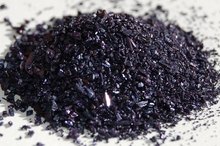Hazards of Acids & Bases
Acids and bases are chemicals that are dangerous to human tissue. They may cause chemical burns, respiratory distress and fire hazards 1. The safety hazards are more serious when working with concentrated forms of acids and bases, but injuries can occur even with dilute solutions. Before you begin working with any acid or base, research the safe handling of that specific chemical. Know the proper methods for storing, using and disposing of your chemicals and have a plan to deal with spills or exposure.
Respiratory Hazards
Many acids and bases are highly toxic by inhalation. The fumes or airborne mist will irritate the mucous membranes of the nose, throat and lungs. In severe cases, exposure may result in pulmonary edema, a life-threatening condition in which fluid in the lungs prevents oxygen from reaching the bloodstream.
Contact Hazards
How to Treat an Acid Skin Burn
Learn More
Concentrated acids and bases are corrosive and cause chemical burns if they come into contact with the skin, eyes or internal organs. Acid burns usually cause immediate pain and tissue damage. Hydrofluoric acid penetrates the skin rapidly and may even result in bone damage. In contrast, you may not notice right away if your skin contacts a base. Since the pain is delayed, this may mean your skin is exposed for a longer time. Never add water to acid since this becomes a splash hazard 1. Instead, slowly add the appropriate amount of acid into the water.
- Concentrated acids and bases are corrosive and cause chemical burns if they come into contact with the skin, eyes or internal organs.
- Hydrofluoric acid penetrates the skin rapidly and may even result in bone damage.
Fire Hazards
When acids or bases are mixed with other chemicals, combustion can occur. In addition, acids can react with certain metals to release hydrogen gas, a highly flammable substance. Hydrogen gas is also released when some bases react with aluminum, magnesium, tin, and zinc metal. Never work with acids and bases while smoking or using other open flames, such as a Bunsen burner. (See Ref 1)
- When acids or bases are mixed with other chemicals, combustion can occur.
- Hydrogen gas is also released when some bases react with aluminum, magnesium, tin, and zinc metal.
Protective Equipment
Side Effects of Drinking Water With High Haloacetic Acids
Learn More
Protective gear should be used every time you handle acids and bases. Wear safety goggles or safety glasses that include side shields, as well as a laboratory coat or coveralls, and closed-toe shoes. Choose protective gloves that are resistant to the chemical you are handling. Nitrile gloves are useful for most acids, but you should check the safety requirements for all chemicals and concentrations that you use. Depending on the amounts you work with, you may need to add a face shield or respiratory equipment.
- Protective gear should be used every time you handle acids and bases.
- Nitrile gloves are useful for most acids, but you should check the safety requirements for all chemicals and concentrations that you use.
Related Articles
References
Writer Bio
Amy Liddell has been writing on health and medicine since 2004. She is also a biomedical scientist and studies human cancer. Her articles have appeared in scientific journals, medical textbooks and on health-related consumer websites. Liddell holds a Doctor of Philosophy in biological and biomedical sciences from Harvard University.







